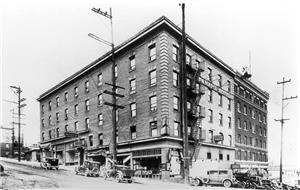In August 1910, the Panama Hotel opens at 605 1/2 S Main Street, in the heart of Seattle's Nihonmachi (Japantown). The builder and designer is Sabro Ozasa, a Japanese American architect and graduate of the University of Oregon. The Panama is a five-story workingman's hotel, with businesses located on the first floor. The businesses include a laundry, a dentist, a tailor, a pool hall, a book store, a florist, and a sushi shop. The upper floors contain single occupant residences. In the basement, there is (and remains to this day) a "sento," a Japanese-style public bathhouse. The Panama Hotel's sento, named the Hashidate-Yu, is the only such bathhouse remaining intact in the United States today (2010).
The Sento
The Hashidate-Yu drew on a 1,200-year-old tradition of Japanese bathing. Japanese sentos were a central feature of Buddhist temples, used in purification rites. The temples also provided baths for the general public, since many homes at the time did not have private facilities. Eventually, the religious implications faded, but the sentos continued to be used as gathering places. Japanese immigrants sought out sentos upon arrival in their new communities. The Hashidate-Yu had separate baths -- one for men and one for women and children.
Over the years the Panama Hotel served as a home for generations of Japanese immigrants, Alaskan fishermen, and international travelers. The combination of businesses, hotels, and bathhouses provided necessary services for the community. Facilities like the sentos allowed the Japanese immigrants to share their cultural traditions. Before World War II, there were at least four sentos in Seattle: the Hashidate-Yu, the Shimoji, the Hinode, and the Naruto. Most of Seattle's Nihonmachi, like many across the western United States, disappeared during World War II when the United States government forced 120,000 people of Japanese ancestry into internment camps. In Seattle many families packed their belongings into trunks and suitcases and stored them for safekeeping in the hotel’s basement.
Abandoned Property
Sadly, many of the families never returned to collect their belongings. Takashi Hori (who was himself interned from 1942 to 1945), owned and ran the Panama Hotel from 1938 to 1985. He found more than 50 trunks of property and made several attempts to reunite the items with their owners. After the war the Hashidate-Yu bathhouse in the hotel basement was re-opened and was run by Fukuo and Shigeko Sano until the mid-1950s. Sentos gradually fell out favor, as many Japanese Americans felt compelled to abandon their traditions during and after the war. Also, modern houses usually included bathing facilities.
In 1985, Jan Johnson bought the Panama Hotel from the Hori family and began renovations. She too attempted to find the owners of the property left in the hotel. She then took the belongings that were left unclaimed and created a small museum in the basement of the hotel. The artifacts include old Japanese American photographs, a dusty footlocker, a cloth coat with a fur collar, a pair of men’s socks, and other pieces of everyday life. Many of the items have been included in temporary exhibitions at Ellis Island and the Japanese American National Museum.
National Landmark
In 2001, Johnson opened The Panama Hotel Tea House, an Asian tea house on the Main Street side of the building. Large format black-and-white photos hang on exposed brick walls. The photos depict people and scenes from a bygone era -- launderers, shopkeepers, a butcher, a stationer, a bookstore, a florist, a dentist, and a parade float. A long sleek counter is lined with tea. Gleaming hardwood floors surround a “window” to the floor below, revealing a part of the museum. Visitors can take a tour of the Hashidate-Yu sento, which looks much as it did when it was open for business, complete with the mosaic floors, wooden lockers, and marble and concrete tubs.
The tea house provides a means for people to experience a piece of Japanese culture and explore a bit of history. It also provides a means for Japanese Americans to reconnect with their past. Since the teahouse opened, many elderly Nisei have come to the hotel. They have filled in the dates, and names of the people in several of the photographs. For many of them, Ms. Johnson reports, it is an emotional experience, bringing back memories of the thriving community that once lived and worked in this neighborhood.
The Panama Hotel was declared a National Historic Landmark building in 2006.

